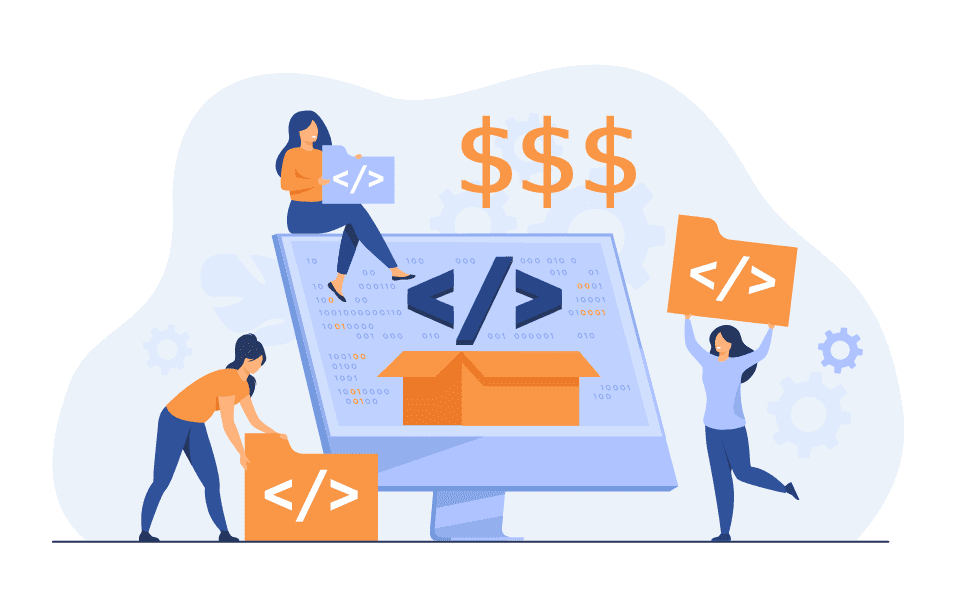Ecommerce is the new frontier of sales. Shopify, Amazon, or your own proprietary website, every platform has its strengths and weaknesses. The key to running a successful ecommerce website operation is knowing how to balance your costs and profits efficiently by understanding the bigger picture. Experts predict that over 15% of all transactions in the US will take place through ecommerce in 2022, here’s how you can capitalize on that.
What Kind Of Store Are You Going To Have?
The cost of running an ecommerce store varies according to your business model. Your target audience will determine your marketing and operations strategy, including inventory management and shipping models. Let’s have a look at some examples.
- Business to Consumer (B2C): This is the most common business model, in which businesses sell consumer-oriented products. If you’ve shopped online for groceries or a movie, that’s a B2C transaction. B2C ecommerce websites can have lower costs due to their shorter sales cycles and more direct marketing avenues, however, this isn’t a general rule and varies depending on the business.
Ecommerce websites help drive down costs for B2C models by enabling smarter marketing methods such as checkout strategies that use machine learning to suggest items a customer might find useful. - Business to Business (B2B): B2B involves businesses offering their products and services to other businesses. A B2B operation sees longer sales cycles as purchases can often take longer to execute due to bulk ordering and vetting. An upside is that average revenue per order can be higher than it would be for a B2C transaction here.
Recent trends in B2B ecommerce websites point towards increased budget and cost allocation towards creating B2C-like websites. The shift towards snappy consumer-oriented websites indicates a convergence between B2C and B2B models. - Consumer to Business (C2B): A newer trend that’s popped up with the growth of internet penetration is the C2B model. It involves consumers selling their products and services to businesses. A well-known example of this might be freelancing websites, where skilled professionals bid for projects that suit their skills using ecommerce platforms.
The model you choose is what will determine how much your ecommerce website costs. Let’s look at a popular example: dropshipping. Dropshipping refers to a business model where the owner acts as a middle man for consumers, passing their order on to a supplier for a small cut.
In 2020, the market value for dropshipping ecommerce crossed $128 billion globally. Since dropshippers don’t have to maintain their own inventory, their operating costs are lower than they would be if they were directly selling their goods. However, their profit margins are also suitably lower, which is balanced by the low cost of setting up and maintaining a website on an ecommerce platform.
Picking a Platform
With the market advancing at a steady pace, business owners have plenty of ecommerce platforms to choose from to set up their website, depending on their business model and potential costs.
A major upside of using an ecommerce platform is the fact that you don’t necessarily need to know HTML or other coding languages to set your store up, so anyone can set up a business and start moving units right away. That said, if you do know web-oriented languages, some platforms such as BigCommerce will let you customize certain features to your liking.
BigCommerce
BigCommerce specializes in high-volume orders, but also offers comprehensive functionality for smaller business owners. Features like the ‘Channel Manager’ make it easy for businesses that operate at scale to link and set up their products on other marketplaces such as Amazon and eBay. Automated shipping options and sales tax tools are handy for businesses that might not have big teams ready to handle these tasks.
A con that comes with the scale-oriented nature of BigCommerce is cost. For example, if you’re not using one of the free themes provided for your ecommerce website, it can cost you anywhere from $150 to $300 to buy a theme from the marketplace. Similarly, the monthly costs can be higher than on other platforms depending on how many units you’re moving.
Shopify
With 3.2% of the market share as of 2021, Shopify hosts over a million live websites. Shopify’s appeal is its ease of use. Business owners have the option to set up their website with absolutely zero knowledge of coding using readymade themes and template options.
Accessibility is a unique benefit for Shopify users. For as little as $9 a month, Lite users get access to the entire Shopify feature catalog including 24×7 support and no limits on the number of products you can sell. This low-cost ecommerce website offers a great alternative to pricier options for people who are just starting out. There are also other plans such as the $2,000/month option for sellers moving larger order quantities.
The platform is, however, not without its disadvantages. The low monthly costs are offset by the many add-ons that customers have to purchase if they want extra features such as discount banners. The lack of support for CSS customization is also a downside that business owners looking for more flexibility might want to look out for.
Magento
Magento, acquired by Adobe back in 2018, offers business owners functionality and individualization, if they have the scale to use it. As an open-source ecommerce website, Magento can be fine-tuned for the smallest details at a monthly cost structure. Open-source here means that you can change the source code of the website to accommodate any requirements your business might have.
Other useful Magento features include the ability to price your products differently depending on the type of customer that might be interested in buying it, support for multiple languages, and the power to manage a number of stores at the same time.
If it looks like these features are oriented towards businesses that have already acquired a certain level of scale, they are. While the community version of Magento is free, the Enterprise version can cost thousands of dollars more than what you’d pay for an alternative ecommerce website.
Payment Options
Along with cost considerations, an important aspect of ecommerce platforms that a business owner should keep in mind is payment options. While all major platforms offer the usual options like debit and credit cards, certain businesses might target niches that require a little more payment flexibility.

If you’re running a business oriented towards crypto, you might want to invest a little more into an ecommerce website that offers you the flexibility to integrate and accept crypto payments, despite the cost. Another example would be a business that runs brick-and-mortar stores along with their online ventures. A business like this could benefit from a platform with payment processing that offers point-of-sale perks.
Website Costs
Picking a platform for your website and setting up shop is just the first step. Other costs that come with setting up an ecommerce website have to be considered too, as these can add up quickly. Depending on which platform you go with, some of these will be integrated already. Let’s run through some of the big ones.
Security
Keeping your site secure is non-negotiable if you want to attract and retain your customers. A recent industry survey indicates that over 75% of senior industry IT leaders lack confidence in their organization’s security. Websites that don’t have the usual security certifications can become easy targets for cyberattacks, including debilitating ones like Distributed Denial of Service (DDoS), which can drive up ecommerce website operating costs significantly.
Here are some best practices to keep in mind to save on securing your website:
- PCI-DSS Certification: Getting your website Payment Card Industry Data Security Standard (PCI-DSS) certified is critical for maintaining your customer’s trust. Essentially, this certification tells buyers that their private data, including card details, addresses and names, won’t be stored after their purchase.
Big ecommerce platforms come with this certification which extends to all their stores by default, so if you’re using Shopify or BigCommerce, you won’t have to worry about getting your store certified. You’ll only really have to look out for PCI-DSS and SSL certification if you’re going independent with your own website, in which case you might see higher costs setting up your ecommerce website.
- Regional Compliance: If your business sells internationally or even domestically to certain regulated areas, not complying with privacy legislation can lose you an entire segment of potential customers. The General Data Protection Regulation (GDPR), for example, operates in the EU and even applies to foreign businesses that sell to EU citizens.
Platforms like Shopify save businesses the hassle of hiring consultants to ensure their website is GDPR-compliant, along with assisting them in compliance by providing documentation. If you’re looking to operate independently of ecommerce platforms, make sure you’re aware of the changes you might need to make in order to sell to EU customers. - Cloud Protection: DDoS attacks can overwhelm servers and knock ecommerce websites out for days, leading to thousands in maintenance and repair costs. Losses can mount up depending on the severity of the attack and the protection you have in place. A key benefit that ecommerce platforms offer small business owners is cloud protection.
Cloud protection means that even if your website gets hit by a DDoS or other forms of cyberattacks, you won’t lose everything. Your website gets backed up and hosted on a reliable set of distributed servers, which makes it much harder for an attacker to take your website down.
Design and Marketing
Attractive, snappy, and most importantly, responsive website design can make or break an online business. Customizing your website for your customers helps with retaining existing customers, gaining the trust of potential new ones, and can be a powerful tool for lowering ecommerce website costs while optimizing your marketing strategy.
- Demographics: Understanding the general user demographic of your website through insights provided by your ecommerce platform or surveys can help you formulate a more cost-efficient marketing strategy.
For example, if you find out that most users who visit and complete purchases on your store are between the ages of 18-21, you gain the option to design your shopping experience around that demographic, switching up the lingo and user experience (UX) to suit them. - Design Choices: The amount you end up paying for the overall look of your website will vary on the degree of customizability you opt for. If you’re using free templates and themes from Shopify to quickly launch your business, you’ll save on ecommerce website-designing costs such as paying artists for graphics. Businesses that need more flexibility and go for pricier alternatives will naturally incur higher initial costs.
- Marketing: A massive amount of the budget for businesses, especially those just getting off the ground, goes to marketing. Finding a solid subscriber list and designing an email marketing campaign, for example, can be time-consuming and even risky if you don’t have a large pool of capital to draw from.
Ecommerce platforms like BigCommerce can help users save on marketing costs by offering in-built functionality for email and social media marketing.
Value for Money
Managing upfront and operating costs intelligently in an era of hidden fees and a multitude of options is one of the biggest challenges for upcoming ecommerce websites. Follow the BESTWEB blog to find out how to get the most out of your investment.

